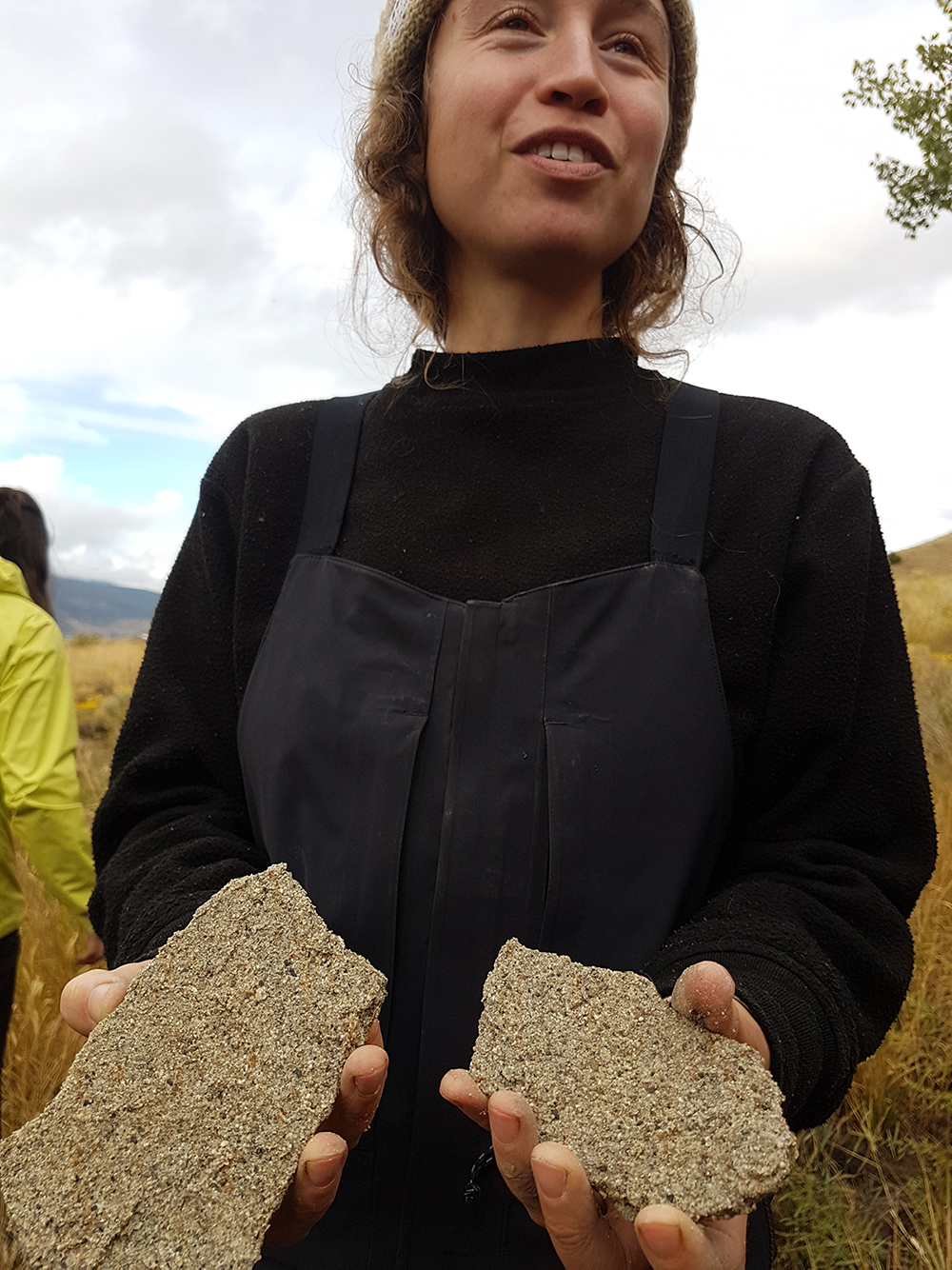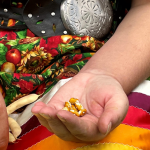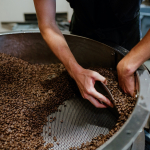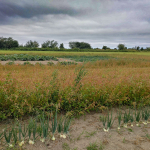Ask an Expert: Soil Testing

Tools for your Nutrient Management Toolkit
Amy Norgaard, Dru Yates, & Emma Holmes
Every year farmers align countless variables to produce healthy crops that make it to market. Crop planning. Bed prep. Transplanting. Irrigation. Weed management. Pest management. Harvest. Storage and transport. Typically, there is a sweet spot in terms of either quantity or timing for each of these, and there are indicators or measures to stay in that ideal range. For example, the weather forecast and local temperatures highlight best times for transplanting, thermometers track temperatures in storage facilities, and in-field insect traps help monitor pest pressures. Nutrient management is another one of these farm management components that we can stack in our favour—and soil sampling is an essential tool to make informed decisions in this area.
The main reason for soil sampling in agriculture is to assess soil fertility and related properties like pH and texture. Results not only inform management practices for the current season but can also act as a report card for past decisions. Just like we can feel or measure the soil to make irrigation decisions, we can use soil tests to provide us with a snapshot of fertility status and amend accordingly. Being able to apply the right nutrients in the right quantities is just another opportunity to add another piece to the puzzle on the way to our yield, quality, and/or productivity goals.
Best Practices for Taking a Soil Sample
When collecting soil for analysis, the goal is to obtain a sample that is representative of the area you are interested in. Since soil properties vary across fields, there are several steps to ensuring the most reasonable average possible.
1. Take several sub-samples from your area of interest and mix them together to get a composite sample:
- If your garden plot is small (100 – 200 sq. ft), take 4 – 5 samples.
- If your garden is larger (500 – 10,000 sq. ft.), take 9 – 10 samples.
- If you are measuring a larger area (i.e. 1 – 25 acres) and that area is relatively uniform in cropping and management history, take about 15 – 30 samples to make your composite sample.
- If your sample area is larger than 25 acres, try to arrange your sampling areas so that a single composite sample does not represent more than 25 acres.
2. Avoid spots that look different from the rest, or that have been managed differently. For example:
- Wet spots in an otherwise well drained field.
- Areas where plants are growing exceptionally well, or exceptionally poorly compared to the rest of the field.
- Greenhouses that are left covered over winter.
- If you are curious about an area that is different from the rest, sample it separately.
3. Make sure each sub-sample is the same volume and is taken to the same rooting depth (usually 6 inches for most nutrient tests).
4. Collect samples randomly from the entire field area. A soil probe is the ideal tool as it is fast and ensures consistency among depth and volume of samples, but if you don’t have one readily available, a trowel or garden spade works well. You will also need a bucket and plastic bags. It helps to pre-label the bags with the sample name using a sharpie so that samples don’t get mixed up! Clean any equipment that comes into contact with the sample (eg. shovel and bucket) with clean potable water and dilute soap.
5. Start collecting samples from the sampling area and add into the bucket. Remove any bits of vegetation, pebbles, or fauna with a gloved hand. Once you have all your sub-samples for your area in a bucket, mix them together and take a ½ cup of soil and put into the prelabeled ziplock bag.
6. Repeat for other samples, making sure to clean your tools between sites.
For more details on taking a soil sample, please refer to this factsheet, which can be accessed by searching for ‘Soil Sampling for Nutrient Management’ on the BC Ministry of Agriculture website
Due to inherent variability in analytical methods, two labs can provide different values for the same nutrient of interest because labs use different extraction methods and equipment. Even when using the same method there is lab to lab variability. Therefore, it is important to use the same lab consistently to monitor trends over time. It is also important to take into consideration the methods used when analyzing the results.
On Testing Compost and Amendments (It’s a Good Idea)
Composts are commonly used in organic agriculture as a source of organic matter and plant nutrients. However, these amendments vary widely in their composition depending on many factors, such as feed-stock, composting process, and storage conditions. These not only affect the initial nutrient content, but also influence nutrient loss prior to spreading, as well as the soil nutrient dynamics (release and availability to crops) when the amendment is spread in the field. Therefore, testing a compost pile shortly before spreading gives us the best snapshot of its composition and represents another tool in our toolkit when making site-specific nutrient management decisions in systems using these products.
Composts can be tested for a variety of properties, including both macro- and micro-nutrient content, carbon to nitrogen ratio (C:N), pH, electrical conductivity (EC), organic matter content, etc. Together, these provide an overall picture of compost quality and can help predict the subsequent effects on soil quality and nutrient supply to crops. The specific parameters to test for depend on the goals for using the product, and any specific concerns or goals. For example, farms that already have salinity issues may want to test potential soil amendment sources for EC as an indicator of salt content to avoid exacerbating this pre-existing situation.
From a broad nutrient management perspective, testing for C:N, nitrogen (N), and phosphorous (P) are valuable first steps in balancing these nutrients, as compost products are often used to supply all or at least part of the N and P needs in organic farming systems. Additionally, these nutrients are important to consider because they are not only needed in significant quantities, but are also environmentally damaging when lost to surrounding ecosystems. In general, applying compost to target crop N requirements results in the over-application of P, and over time we see excess P levels in soils where this management practice is common (Sullivan & Poon, 2012). This highlights the advantage of implementing soil and compost testing, where we can not only monitor our soil P levels over time, but also be aware of the quantity we are applying by testing our amendments.
Finally, while N and P are two important plant macronutrients, compost provides a variety of other plant nutrients that can be important considerations, depending on the crop we are amending, soil test values, and any other farm-specific considerations. Implementing compost testing as a tool to be more informed about the properties of these amendments allows for more specific, targeted use and more efficient, environmentally-friendly farming systems overall.
How to Calculate Amendment Needs
While compost and soil tests answer the question “What’s there?”, there are still a few steps to go from these values to a target amendment application rate in the field. This can often be the most intimidating element and involves a few calculations. However, there are several online or downloadable calculators and resources for this process. The two nutrient calculators listed below are good starting points, and are accompanied by several resource pages and/or documents to get oriented to how they work. The BC Ministry of Agriculture’s Nutrient Management Calculator allows you to pick your lab when inputting your values, and will assist you in choosing the right rate and nutrient source for your crops.
Amendment Calculators:
Organic Cover Crop and Fertilizer Calculator (OSU Extension)
BC Ministry of Agriculture Nutrient Management Calculator
Additional Nutrient Management Resources:
Fertilizing with Manure and Other Organic Amendments (PNW)
Nutrient Management for Sustainable Vegetable Cropping Systems in Western Oregon (OSU)
Soil Fertility in Organic Systems – A guide for gardeners and small acreage farmers (PNW)
Post-harvest Nitrate Testing
The post-harvest nitrate test (PHNT) is a soil test performed in the late-summer to early-fall to evaluate nitrogen (N) management, and is another soil test to add to your nutrient management toolkit. This test measures the amount of nitrate-N remaining in the soil following harvest, and represents the plant-available N that was not used by the crop during the growing season.
Nitrate is highly mobile within the soil system and so is highly susceptible to leaching during winter months. For example, in coastal BC, effectively all soil nitrate is assumed to be lost from the root zone (in absence of an established cover crop) due to high winter rainfall. As such, it is:
1. common for spring nitrate-N soil test values to be minimally informative, and
2. important to manage soil N in ways that keep PHNT values low.
The PHNT is often referred to as a “report card” assessment of N management as it is used in retrospect—an evaluation of the impacts of nutrient management decisions that were made for the previous season. It provides a way for growers to assess and adjust their N management, to both get the most effective use out of the fertilizer inputs they are paying for, and to reduce environmental impacts of excess nitrates entering waterways.
| Rating | General Interpretation | PHNT (kg/ha)
0-30 cm |
| Low | Continue present N management | < 50 |
| Medium | Adjust N management to improve plant uptake efficiency | 50-99 |
| High | Reduce N inputs, implement strategy to reduce N leaching (e.g. cover crop) | 100-199 |
| Very High | >200 |
Table 1. Post-Harvest Nitrate Test (PHNT) ratings developed for corn and grass in the B.C. Lower Mainland (taken from Kowalenko et al. 2007).
To take a sample for PHNT, follow the general instructions for a taking a soil sample (see above in ‘Best Practices for Taking a Soil Sample’), plus the following modifications. Note that PHNT sampling protocols are somewhat crop and region specific. The following are generalized tips:
Timing: the general guideline is to sample after harvest, and before cover crop seeding, soil amending, and significant rainfall. For example, sampling before 125mm cumulative rainfall in south coastal BC on fine to medium textured soils is ideal.
Depth: sample to a minimum of 30cm. This is deeper than standard nutrient sampling recommendations.
Adjust for volume: take the nitrate-N value that you get from the soil lab and multiply by depth (0.3m), multiply by the bulk density of the soil (kg/m^3), and divide by 100 to get PHNT value in kg/ha. Soil bulk density will vary by soil type, and farm-specific values can be attained by paying for a bulk density test at a soil lab. The finer the texture, the denser the soil – many commonly used book-values fall between 1150 to 1300 kg/m^3.
For certain forage crops in coastal BC, such as silage corn and grass, target PHNT values have been developed to indicate whether N inputs should be managed differently in the following season. Under these rating systems (Table 1), higher ratings mean lower N-use efficiency and greater risk for leaching loss of nitrate-N.
The typical, potential reasons for inefficient N-uptake are:
- N applications were in excess of total crop needs;
- N was not applied at the optimal time(s) for crop uptake; or,
- N was not applied where it was accessible to plant roots, or that other growing conditions (e.g. moisture, temperature, other nutrients) were limiting to crop uptake of N.
Relative differences in PHNT values are a useful tool in N management decisions, regardless of crop-specific target PHNT values. If you can identify a field or crop with high PHNT relative to your other fields, this is something to note, adjust nutrient management, and evaluate how that impacts your PHNT values the following season. This PHNT approach to N testing will provide much more insight into your N management than the N values you will receive from your spring soil tests. To address the need for more PHNT information in other field vegetable crops besides silage corn and grass, work is ongoing in BC to better understand PHNT testing and its implications.
Further detail on taking samples and interpreting PHNT values is available through the OSU Extension Catalog, search ‘Post-Harvest Soil Nitrate Testing’.
Assistance can also be found by contacting your Organics Specialist, Emma Holmes (Emma.Holmes@gov.bc.ca) at the BC Ministry of Agriculture.
Soil Labs
AGAT Laboratories
120 – 8600 Glenlyon Parkway, Burnaby, BC V5J 0B6
Phone: (778) 452-4000
Exova (formerly Bodycote/Norwest)
#104, 19575 – 55A Avenue, Surrey, BC V3S 8P8
Phone: (604) 514-3322 Fax: (604) 514-3323
Toll free: (800) 889-1433
Maxxam Analytics (formerly Cantest Ltd.)
4606 Canada Way, Burnaby BC V5G 1K5
Phone: 604-734-7276 Toll-free: 1 (800) 665-8566
Email : info@maxxamanalytics.com
Ministry of Environment Analytical Laboratory
4300 North Road
PO BOX 9536 Stn Prov Govt Victoria, BC
Phone: 250-952-4134
Email: NRlab@gov.bc.ca
MB Laboratories Ltd.
By Courier: 4 – 2062 West Henry Ave, Sidney BC V8L 5Y1
By Mail: PO Box 2103, Sidney BC V8L 3S6
Phone: (250) 656-1334
Email: mblabs@pacificcoast.net
Pacific Soil Analysis Inc.
5 – 11720 Voyageur Way, Richmond BC V6X 3G9
Phone: (604) 273-8226
Email: cedora19@telus.net
Plant Science Lab (affiliated with TerraLink Horticulture Inc.)
464 Riverside Road, Abbotsford, BC V2S 7M1
Phone: (604) 864-9044 x1602
Email: pwarren@terralink-horticulture.com
Amy Norgaard: Amy has a BSc in Agroecology and is now working on a MSc in Soil Science in the Sustainable Agricultural Landscapes lab at UBC. She has worked on several small-scale organic farms and is an Articling Agrologist with the BCIA. Her research is focused on nutrient management on organic vegetable farms. She can be reached at: amynorgaard@alumni.ubc.ca
Dru Yates: Dru has a M.Sc. in Soil Science from UBC, is an Articling Agrologist with the BCIA, and currently works as a consultant with E.S. Cropconsult Ltd. Her work includes providing integrated pest management (IPM) services to vegetable and blueberry growers throughout the Fraser Valley, as well as performing sampling and local research trials related to nutrient management. She can be reached at: dru@escrop.com
Emma Holmes: Emma Holmes has a B.Sc. in Sustainable Agriculture and a M.Sc. in Soil Science, both from UBC. She farmed on Orcas Island and Salt Spring Island and is now the Organics Industry Specialist at the BC Ministry of Agriculture. She can be reached at: Emma.Holmes@gov.bc.ca
References
Kowalenko, C.G., Schmidt, O., and Hughes-Games, G. (2007). Fraser Valley Soil Nutrient Study 2005. A Survey Of The Nitrogen, Phosphorus And Potassium Contents Of Lower Fraser Valley Agricultural Soils In Relation To Environmental And Agronomic Concerns.
Sullivan, C. S., & Poon, D. (2012). Fraser Valley Soil Nutrient Survey 2012.
Feature Image: Amy Norgaard sampling soil. Credit: Teresa Porter




